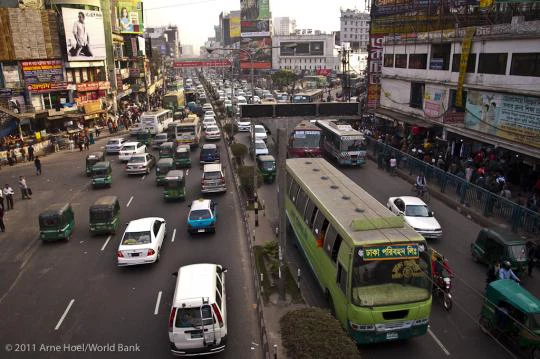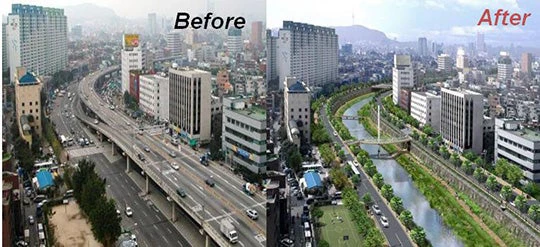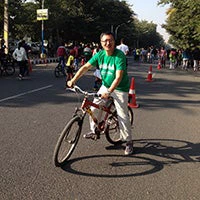Traffic in Dhaka. Arne Hoel/World Bank
Dhaka, the capital city of Bangladesh, has been dubbed as “the traffic capital of the world” because of its chaotic traffic and frequent traffic jams. Some say Dhaka needs more roads, because only 7% of land is covered by roads in Dhaka, while in many developed capital cities it is more than 20%. That argument may hold some water.
For many years, many cities in the world did try to build more roads to relief traffic jams after motorization took place. However, no city has been able to build itself out of congestion. In fact, allocating more urban land to roads means you have to reduce the portion of land allocated for other urban functions, such as housing, industrial, commercial and entertainment. What has also been widely recognized is that building more roads does NOT reduce traffic congestion. It would actually induce more motorized traffic and thus create more traffic congestion.
The trend is reversing. We are now seeing many cities, such as Seoul, London, New York, San Francisco, returning land occupied by roads back to other urban functions, by demolishing via ducts, removing roadside parking lots, and replacing motor vehicle lanes with sidewalks, bike lanes, trees, flowers, coffee tables, benches, or chairs.
Cheong Gye Cheon, Seoul. Dr. Gyeng Chul Kim, Korea Transport Institute
Coming back to Dhaka, one fundamental question the city leaders and all city residents must ask before they rush to any solution is: What kind of city do you want Dhaka to be 20, 30 or 50 years later? Do you want to build Dhaka into a city where the city center is cleaned up to provide space for private cars? You will see big roads, elevated interchanges, parking lots, and lots of cars, but very few people (as shown in the “Before” photo of Seoul)? Or, do you want to keep the current vivid urban lives and provide a clean, safe and comfortable environment for people (as shown in the “After” photo of Seoul)?
If the focus of the urban transport policy and investment is on people, not on private cars, shouldn’t we be more worried by the congestion of people’s movement, and not by the congestion of car’s movements?
Here are some numbers that illustrate the real problems in Dhaka’s urban transport. Out of about total 21 million trips generated in Dhaka metropolitan area every day, only 5% are carried out by private cars, which however use roughly 80% of the road space and are the main cause of traffic congestion. Yet 28% of the total trips are carried out by buses which only use about 5 % of the road space. What’s more, 58% of the total trips are made by walking, bicycling, or riding on rickshaws, also called non-motorized transport modes (NMT). But these NMT modes barely get proper allocation of road space. There are no dedicated bicycle or rickshaw lane on any roads in Dhaka and less than 25% of roads have separated, paved sidewalks, most of which are either occupied by parked cars or damaged without proper maintenance. NMT users literally have to fight with vehicles for their right of way on roads and thus expose their lives to huge risks. During my visit to Dhaka in April, a local newspaper reported that 12 people (including one entire family) had died in traffic accidents on one single day; all of them were NMT users.
With the above numbers, I think even a person who has no transport planning or traffic engineering background would know what Dhaka should do to address its transport problems: to give higher priority, more space, and better infrastructure to public transport and non-motorized transport, which meet mobility needs of 86% of the people in the city while only consuming a small portion of the road space and urban land. That is exactly what the World Bank experts are helping Dhaka to do now, through the Bangladesh Clean Air and Sustainable Environment (CASE) Project. The project is promoting safe pedestrian mobility in Dhaka by actively rehabilitating and improving sidewalks and constructing foot over bridges. It is also improving traffic management by improving intersections, installing traffic signals and training the police in the enforcement of traffic signalization. Under the CASE project the feasibility of a 20 km Bus Rapid Transit (or BRT) line from the airport to Buriganga Bridge was studied. We are also working on a new project - Dhaka Bus Rapid Transit Project – with the aim to offer a low cost high efficient solution to public transport in the congested city of Dhaka. Please let us know your thoughts and let us work together to help Dhaka improve its urban transportation.




Join the Conversation